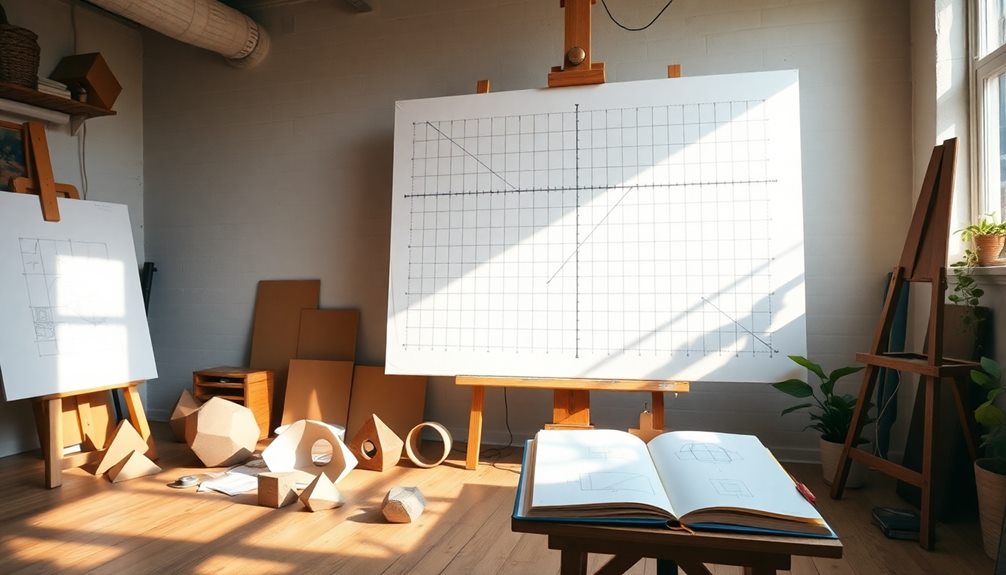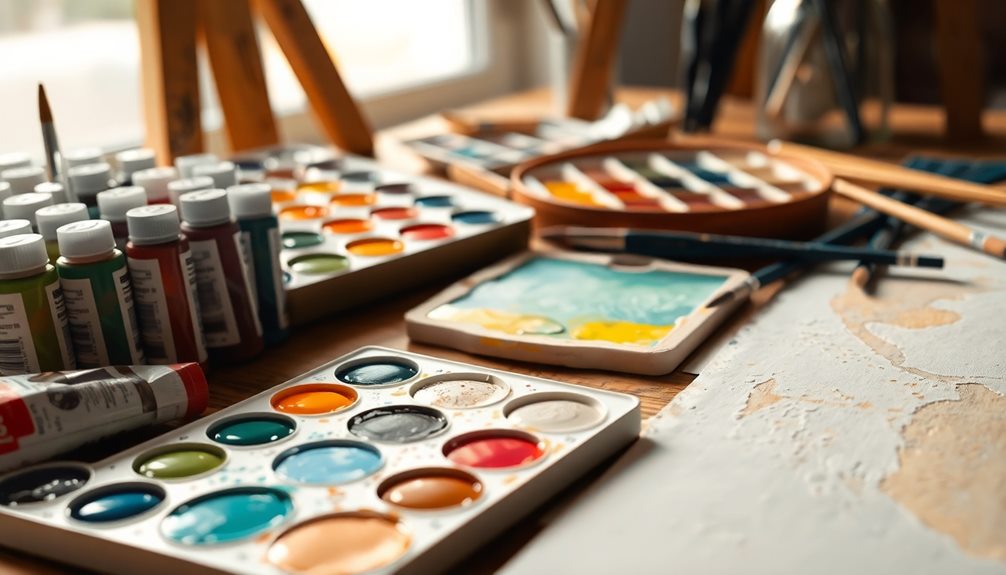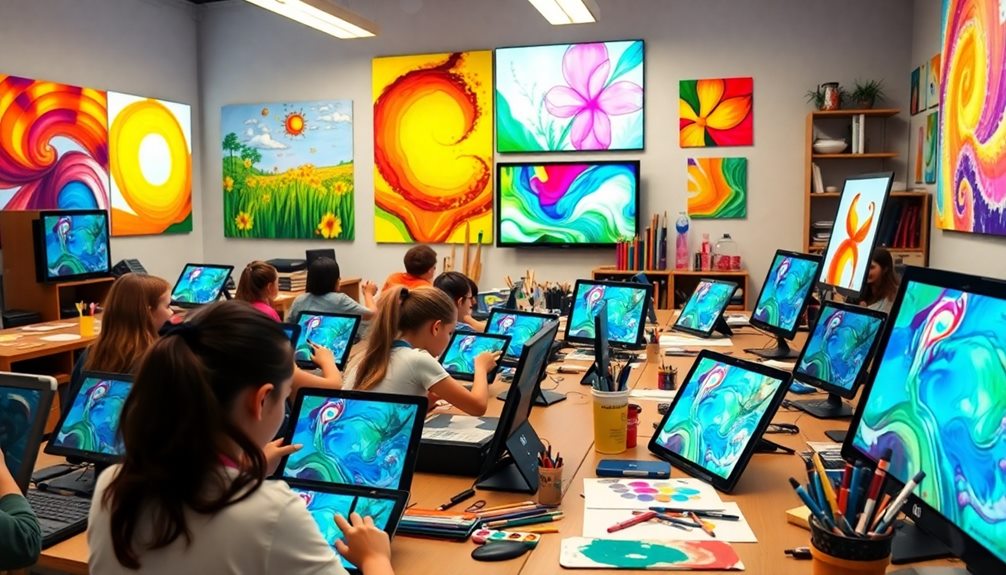Understanding perspective in art helps you create depth and realism in your work. It involves techniques like linear perspective, which uses vanishing points to make flat surfaces appear three-dimensional. You can explore one-point, two-point, and even three-point perspectives, depending on the angle you're depicting. Aerial perspective adds to this by showing distant objects as lighter and less detailed. Manipulating eye level and horizon line affects how viewers perceive your scene. These concepts not only enhance your art but also invite emotional engagement. If you're curious about how diverse voices influence these techniques, there's much more to uncover.
Key Takeaways
- Perspective in art creates the illusion of depth and volume on a flat surface through techniques like linear and aerial perspective.
- One-point, two-point, and three-point perspectives utilize vanishing points to enhance realism and alter viewer perception.
- Aerial perspective employs color and atmospheric effects to depict distance, making far-off objects appear lighter and less saturated.
- Eye level and horizon line positioning are crucial for spatial relationships, influencing how objects are perceived in a composition.
- Manipulating perspective can evoke emotions and challenge traditional narratives, fostering inclusive discussions on identity and representation in art.
Definition of Perspective

Perspective in art is an essential technique that helps you depict three-dimensional objects and spaces on a flat surface, creating a convincing illusion of depth and volume. At the heart of this technique are key elements like the horizon line and vanishing points. The horizon line represents your eye level and serves as a reference point in your composition.
When you use linear perspective, you draw parallel lines that converge at a vanishing point on the horizon line. This convergence creates the illusion that objects recede into the distance, allowing you to portray depth effectively. Understanding these components is vital for achieving realism in your artwork.
Linear perspective was formalized during the Renaissance by artists like Filippo Brunelleschi and Masaccio, who integrated mathematical principles to enhance spatial representation.
Types of Linear Perspective

When you explore the different types of linear perspective, you'll find that each offers unique ways to create depth and realism in your artwork. Understanding these techniques is essential for accurately depicting spatial relationships.
| Type of Perspective | Description |
|---|---|
| One-Point Perspective | Uses a single vanishing point; best for direct views, like a straight road or hallway. |
| Two-Point Perspective | Involves two vanishing points; ideal for angled views, such as the corners of buildings. |
| Three-Point Perspective | Adds a third vanishing point; creates extreme angles, often used for tall structures or when looking down from a height. |
One-point perspective simplifies depth, making objects appear closer or further away based on their distance from your single vanishing point. Two-point perspective adds complexity, enhancing the realism of your compositions. Meanwhile, three-point perspective can dramatically alter your scene's perception, offering a dizzying view that captures the viewer's attention.
Aerial Perspective Techniques

Aerial perspective techniques play an essential role in enhancing the depth and realism of your artwork. By employing this method, you create the illusion of depth, making your scenes come alive.
Aerial perspective, also known as atmospheric perspective, involves depicting distant objects as lighter and less saturated in color compared to those in the foreground. This difference helps simulate the effects of the atmosphere on vision, making distant elements appear hazy and less distinct.
You can further enhance three-dimensional space in your compositions by utilizing color temperature. Warmer colors, like reds and yellows, seem to advance towards the viewer, while cooler colors, like blues and greens, recede into the background. This technique is especially effective in landscape painting, where overlapping layers of mountains or trees convey distance and depth.
Understanding aerial perspective allows you to create more dynamic and realistic compositions. By mastering this technique, you contribute to the overall narrative and emotional impact of your artworks.
Eye Level and Horizon Line

Understanding how to manipulate eye level and the horizon line is essential for creating compelling artwork. Your eye level directly corresponds to the height of the horizon line, influencing how you perceive objects within your composition. When you raise your eye level, the horizon line elevates, causing objects above it to slope downward. Conversely, if you lower your eye level, objects below the horizon will appear to slope upward.
Positioning the horizon line correctly is vital for achieving accuracy in perspective. It dictates the spatial relationships between foreground and background elements, helping you create depth in your artwork. For instance, aligning your eye level with a character's height fosters a direct engagement between the viewer and the subject, making the scene more relatable and immersive.
Pay attention to how changes in your perspective can shift the viewer's experience. By experimenting with different eye levels and horizon lines, you can manipulate the emotional impact of your artwork.
Whether you're aiming for a dramatic effect or a serene landscape, understanding these elements will greatly enhance your artistic expression.
Manipulating Perspective in Art

Art's ability to manipulate perspective opens up a world of creative possibilities, allowing you to evoke powerful emotions and enhance your visual storytelling. By intentionally using vanishing points, you can create dramatic effects that draw viewers into your work.
Surrealist artists often exploit this technique, crafting eerie cityscapes that challenge reality and immerse you in unsettling, dreamlike environments.
In contrast, Cubist artists like Pablo Picasso redefine perspective by flattening objects and presenting multiple viewpoints simultaneously. This manipulation not only alters how you perceive space and form but also invites you to engage with the artwork in a new way.
Abstract perspectives, such as those created by David Hockney, utilize multiple vanishing points and complex spatial relationships, inviting you into a fragmented yet dynamic visual experience.
Techniques like optical illusions, combined with monochromatic palettes, can further intensify this manipulation of perspective. By employing these strategies, you can encourage deeper engagement and interaction from your viewers, transforming their experience and emotional response to your art.
Ultimately, manipulating perspective enhances your ability to tell compelling stories and connect with your audience on a profound level.
Perspectives and Cultural Voices

When you explore diverse artistic narratives, you'll notice how gender and racial representation shape the stories being told.
This transformation in artistic expression not only reflects personal experiences but also resonates with the impact of sustainable materials on contemporary art practices.
Artists challenge traditional perspectives, using their unique backgrounds to highlight issues often overlooked.
This shift encourages a richer understanding of identity and culture in the art world.
Diverse Artistic Narratives
Diverse artistic narratives play an essential role in shaping our understanding of identity and representation in the art world. These narratives reflect the unique perspectives of artists, influenced by their backgrounds and experiences. By exploring varied voices, you gain insight into the complexities of culture and identity.
- Artists like Donald Rodney and Sonia Boyce address race and representation through personal narratives.
- Feminist artists such as Lorna Simpson and Cindy Sherman challenge traditional portrayals of women.
- The Guerrilla Girls highlight systemic biases in the art world through impactful messaging.
- Diverse perspectives encourage cultural shifts towards inclusivity.
- These narratives foster critical discussions around identity and representation.
When you engage with these artistic expressions, you're not just observing art; you're participating in a dialogue that critiques societal norms.
You'll discover how perspectives shape representation, revealing the power of individual stories. Embracing diverse narratives enriches your understanding of art and its role in reflecting the world around you.
Gender and Racial Representation
Gender and racial representation in art serves as a powerful lens through which you can examine societal norms and biases. Artists like Donald Rodney and Sonia Boyce leverage their personal experiences to challenge prevailing narratives, using their work to inform and inspire.
Feminist artists, such as Lorna Simpson and Cindy Sherman, highlight gender-related issues, exposing inequalities and advocating for greater representation within the art world.
The Guerrilla Girls take this a step further; their collective efforts aim to combat sexism and racism in the art industry through impactful messaging and public demonstrations. Their work raises awareness about the biases that persist in exhibitions, pushing for change.
As you explore gender and racial perspectives in art, you'll find that these discussions prompt critical conversations around identity and representation, influencing new generations of artists and activists.
Diverse artistic voices play an essential role in driving cultural shifts towards inclusivity. By emphasizing varied perspectives, these artists shape contemporary art narratives and enrich your understanding of the world.
Engaging with their work not only broadens your viewpoint but also fosters a deeper appreciation for the importance of diverse representation in art.
Challenging Traditional Perspectives
Art has long been a mirror reflecting societal norms, yet many artists today are intentionally distorting that reflection to challenge traditional perspectives.
They're breaking boundaries with innovative techniques, such as Cubism, which flattens objects to present multiple viewpoints. This disruption of depth representation encourages you to question what you see.
- Feminist artists like Lorna Simpson and Cindy Sherman expose gender inequalities.
- Racial themes in the work of Donald Rodney and Sonia Boyce advocate for diversity.
- The Guerrilla Girls use impactful messaging to highlight sexism and racism.
- Challenging perspectives prompts critical discourse on representation in art.
- These explorations inspire new generations of artists and activists.
Frequently Asked Questions
How to Explain Perspective in Art?
To explain perspective in art, you can describe how artists create depth on flat surfaces. Highlight techniques like horizon lines and vanishing points, showing how they influence spatial relationships and enhance viewer perception of three-dimensionality.
What Are the Three Rules of Perspective in Art?
Imagine standing on a busy street. To create depth in art, you'll need a clear horizon line, identify vanishing points, and use orthogonal lines. These rules help your artwork convey realism and spatial relationships.
What Are the Four Types of Perspective in Art?
There are four types of perspective in art: one-point, two-point, three-point, and curvilinear. Each offers unique ways to depict depth and space, helping you create more dynamic and engaging compositions in your work.
What Are the Basic Concepts of Perspective?
Imagine standing before a vast landscape. You'll grasp basic concepts like the horizon line, vanishing points, and how distance alters perception. These elements create depth, drawing you into the scene, making it feel alive.
Conclusion
In the grand tapestry of art, understanding perspective is like discovering a hidden door to new dimensions. By mastering various techniques, you're not just creating images, but inviting viewers into your unique world. Remember, each stroke and shift in viewpoint can whisper untold stories, connecting cultures and emotions. So, embrace these concepts and let your creativity soar, transforming the ordinary into the extraordinary. After all, art isn't just seen; it's felt, experienced, and cherished.









